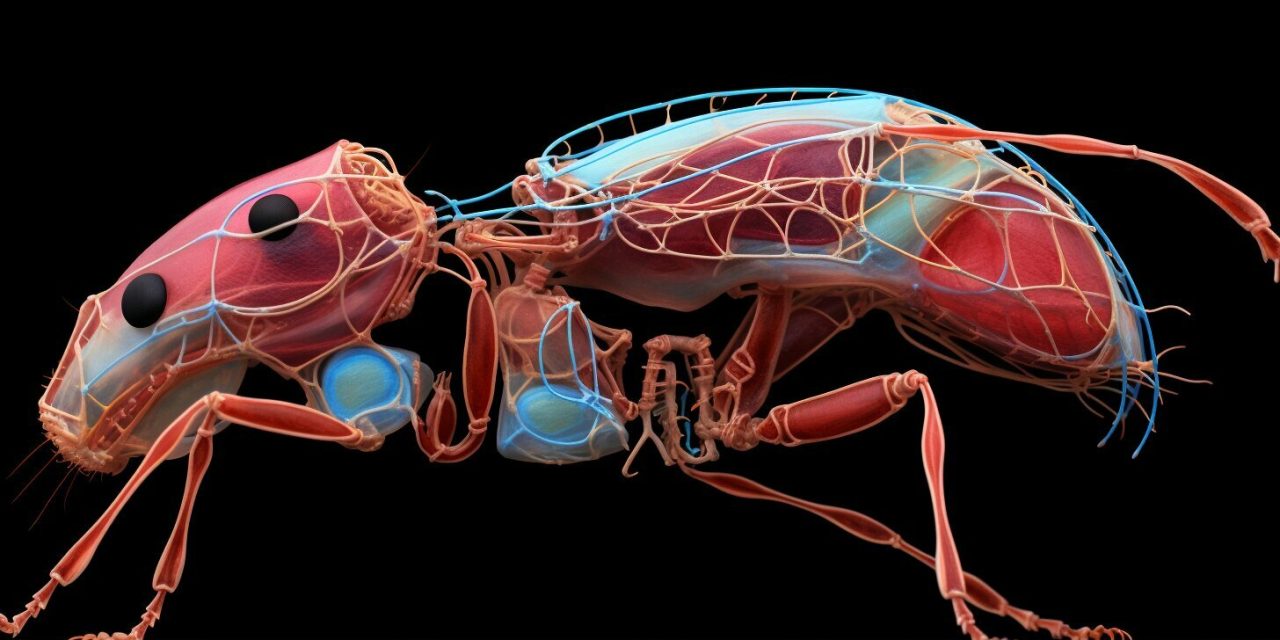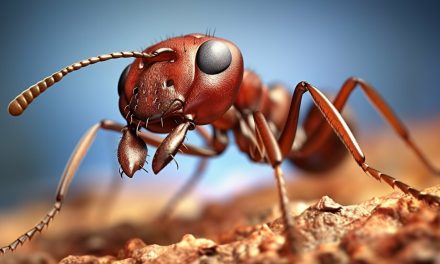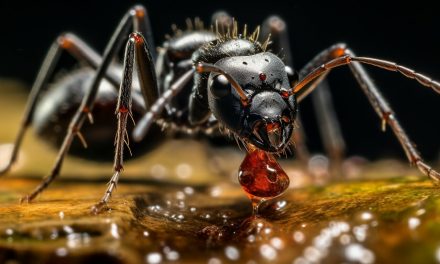This post may contain affiliate links.
Welcome to our deep dive into the fascinating world of insect biology! One of the intriguing questions that arise when thinking about insects’ inner workings is whether they have hearts. Today, we’ll explore this question, examining the anatomy of ants and their circulatory system to understand the role of the heart in their physiology.
Ants are among the most social and industrious insects, with intricate colonies and elaborate division of labor. They belong to the family Formicidae and have a unique anatomy and physiology that enable them to thrive in various environments.
But do ants have hearts? The answer is yes, but not in the way we typically think of hearts. Ants have an open circulatory system, which means that, instead of blood flowing through vessels, a fluid called hemolymph circulates through their bodies in open spaces called hemocoels. The heart of an ant is a simple tubular structure that pumps hemolymph throughout the body.
Key Takeaways:
- Ants have an open circulatory system through which hemolymph circulates instead of blood flowing through vessels.
- The ant’s heart is a simple tubular structure that pumps hemolymph throughout the body.
Understanding Ant Anatomy
Ants may seem like simple creatures, but their anatomy is in fact quite complex. They possess a number of organ systems that work together to keep them alive and thriving in their environments.
One of the most notable features of ant anatomy is their exoskeleton. This hard outer layer protects their internal organs from damage and provides support for their bodies. Beneath the exoskeleton lies the ant’s musculature, which allows them to move and perform daily activities.
The ant’s digestive system is another vital component of their anatomy. Like many insects, they have a specialized organ called the crop that stores food and regulates its distribution throughout the body. In addition, their digestive system includes a stomach and a series of intestines that break down and absorb nutrients from their food.
The respiratory system of ants is also unique. Instead of lungs, they have a series of small tubes called tracheae that deliver oxygen directly to their cells. Waste gases are removed through tiny pores in the ant’s exoskeleton.
The nervous system of ants is dispersed throughout their bodies, with a series of ganglia (clusters of nerve cells) connected by nerves. This allows for quick and efficient communication between different parts of the ant’s body.
Overall, the intricate anatomy of ants plays a crucial role in their survival and success as a species.
Understanding Ant Organ Systems
To truly appreciate the complexity of ant anatomy, it’s important to understand their various organ systems and how they work together.
| Organ System | Function |
|---|---|
| Circulatory System | Delivers nutrients, oxygen, and waste products throughout the body |
| Respiratory System | Delivers oxygen directly to cells and removes waste gases |
| Digestive System | Breaks down and absorbs nutrients from food |
| Muscular System | Allows for movement and physical activity |
| Nervous System | Coordinates and controls all bodily functions |
Each of these organ systems is essential for an ant’s survival, and they all work together to keep the ant healthy and thriving.
Now that you have a deeper understanding of ant anatomy and organ systems, we can explore the fascinating world of insect cardiovascular systems and how they differ from those of humans in the next section.
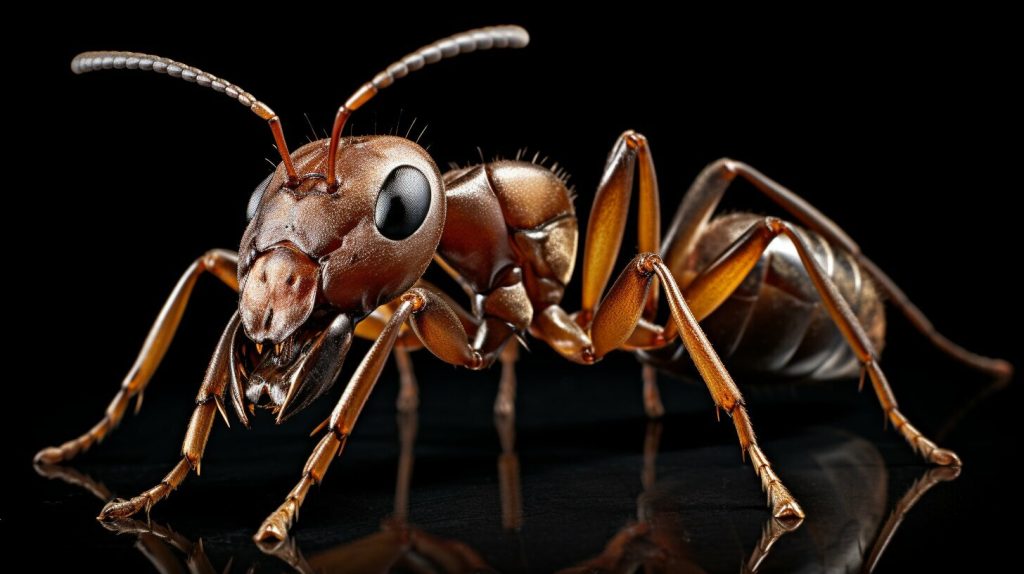
The Insect Cardiovascular System
Ants, like all insects, have an open circulatory system which differs from the closed circulatory system found in humans and other vertebrates. In an open circulatory system, there are no blood vessels; instead, hemolymph (fluid equivalent to blood) flows freely throughout the body cavity, bathing organs and tissues.
The hemolymph is propelled through the body by the contraction of the heart, which in ants is a long tubular structure situated near the top of the abdomen. The ant’s heart pumps hemolymph into the aorta, which leads to the head region and then to the rest of the body.
The ant’s heart is simple in structure compared to the complex four-chambered heart found in humans. It consists of a single tube with several valves that prevent the backflow of hemolymph. The heart is surrounded by a loose network of muscle fibers that contract rhythmically, causing it to beat. However, unlike a human heart, the ant’s heart does not have specialized pacemaker cells; rather, the contractions are initiated by nerve impulses.
The frequency of the ant’s heartbeat varies depending on the species, age, and activity level. Generally, worker ants have a higher heartbeat rate (up to 250 beats per minute) than the queen ants (30-50 beats per minute). During rest, the heart rate drops to around 60 beats per minute in workers and 20-30 beats per minute in queens.
The ant’s heart plays a crucial role in the transport of nutrients, hormones, and wastes throughout the body. The hemolymph also serves as a protective fluid, delivering immune cells to fight infections and removing harmful substances.
Overall, the insect cardiovascular system, including the ant’s heart, is vastly different from that of humans, but it enables ants to thrive in their environments and play important roles in ecosystems.

The Insect Cardiovascular System
Ants, like all insects, have an open circulatory system, which means that hemolymph, a fluid similar to blood, flows freely throughout their body cavity rather than being confined to vessels as in humans. This system is still a circulatory system as it transports nutrients, hormones, and waste products to and from tissues, but it differs in structure and function from the human cardiovascular system.
The ant’s heart is a long, tubular structure that pumps hemolymph into the aorta, a major vessel that runs almost the length of the body. From there, the hemolymph flows to various organs and tissues before returning to the heart through openings called ostia.
The ant’s heart plays a crucial role in maintaining circulation and distributing nutrients and oxygen throughout the body. However, unlike the human heart, which is made up of muscle tissue, the ant’s heart is a simple tube with muscular sections that contract rhythmically to pump hemolymph. Despite this difference, the ant’s heart is essential to its survival and overall physiological functioning.
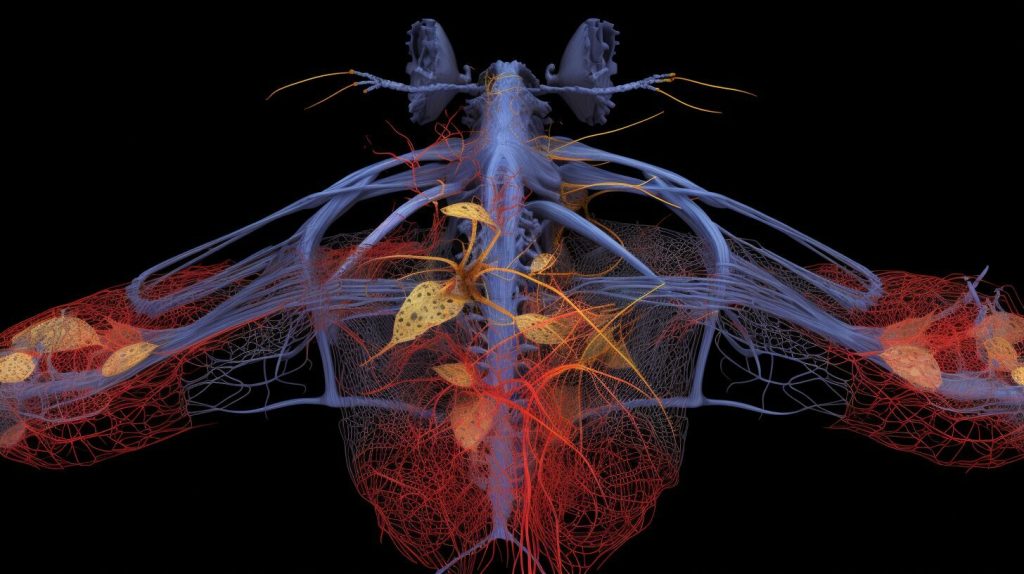
The absence of blood vessels in insects means that the circulatory system is closely intertwined with the respiratory system, where oxygen is directly delivered to the tissues through a network of tracheae, small tubes that branch out from the body surface. This system is highly efficient, allowing ants to rapidly supply oxygen to their rapidly metabolizing tissues.
Overall, the ant’s cardiovascular system is a unique and remarkable adaptation that enables these tiny creatures to survive and thrive in a variety of environments.
The Role of the Ant’s Heart
Now that we know ants have hearts, let’s explore their function in more detail. The ant’s heart is a vital internal organ responsible for pumping the hemolymph, a fluid similar to blood, throughout its body. Unlike the human circulatory system, ants don’t have blood vessels to distribute hemolymph, relying instead on a series of internal chambers and channels.
The ant’s heart plays a crucial role in maintaining the balance of hemolymph in its body. It pumps hemolymph through the aorta, which leads to the head and thorax. From there, the hemolymph is distributed to the rest of the body, providing nutrients, oxygen, and waste removal.
The ant’s heart also helps regulate body temperature, especially in tropical and desert environments where ants are commonly found. Hemolymph circulates near the body’s surface, where it can exchange heat with the environment. The heart pumps hemolymph faster or slower, depending on the temperature, to maintain the ideal body temperature.
Overall, the ant’s heart is a fascinating and essential organ that enables ants to survive and thrive in diverse environments. Its intricate structure and function play a vital role in the ant’s physiology, contributing to their resilience, adaptability, and longevity.
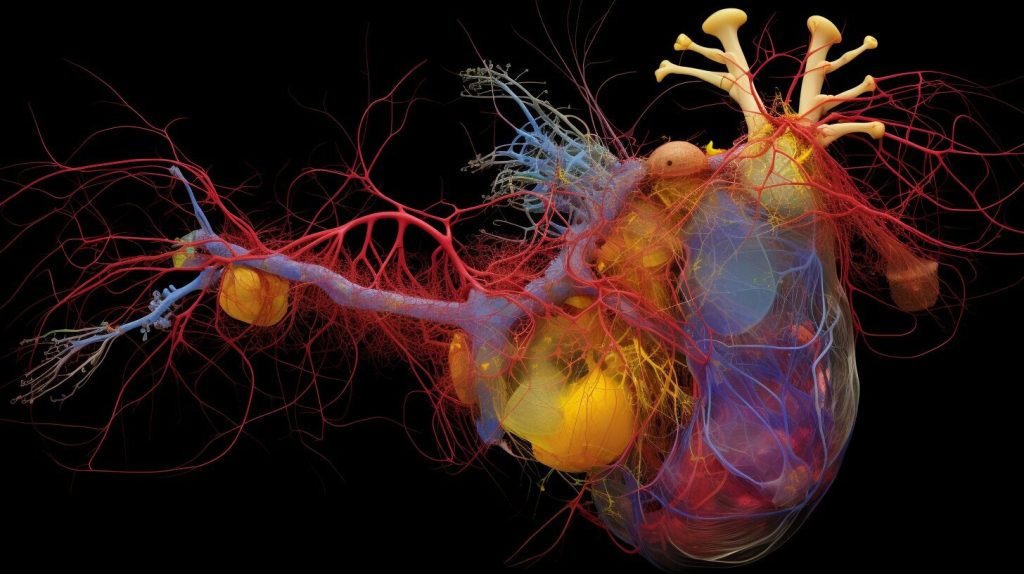
Intrigued by ant biology? Keep reading to learn more about the ant’s heart structure in section 6.
Ant Heart Structure
Now that you understand the importance of the ant’s heart in their overall physiology, let’s examine the structure of this vital organ. The structure of an ant’s heart is relatively simple compared to the complex human heart. It is a tubular structure that runs the length of their body, located in the abdomen.
The ant’s heart consists of a series of chambers that allow for the efficient movement of hemolymph, the insect equivalent of blood. Hemolymph is pumped through the heart by a series of valves, each opening and closing in sequence to keep the flow of hemolymph moving in one direction. The heart rate in ants can vary depending on the species, with some pumping as little as once per second while others can pump as many as 170 times per minute.
The size and location of the ant’s heart can also vary, with larger species typically having larger hearts located closer to the head, while smaller species have smaller hearts closer to the tail. Despite these differences, the basic structure and function of the ant’s heart remain the same.
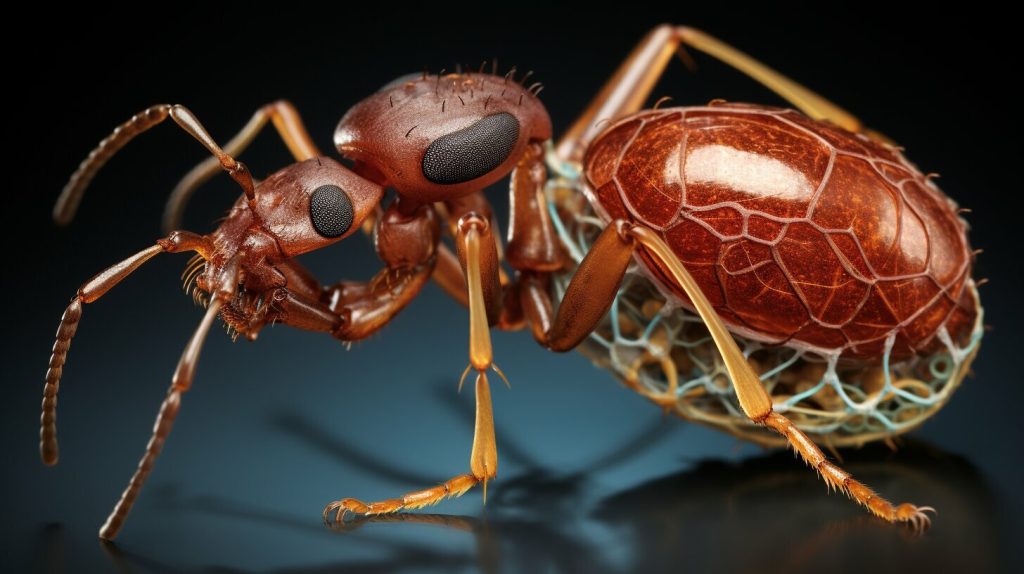
As you can see, the ant’s heart is a fascinatingly simple yet efficient organ that plays a critical role in their survival. In the next section, we will explore the ant’s heartbeat and how it moves hemolymph throughout their body.
The Ant’s Heartbeat
Now that we have explored the cardiovascular system of insects, including ants, let’s dive deeper into the fascinating topic of the ant’s heartbeat.
Unlike human hearts, which have four chambers, an ant’s heart is a simple tube-like structure that runs along its back. The heart pumps hemolymph (the equivalent of blood in insects) through the ant’s body, circulating nutrients and oxygen to its organs.
Interestingly, an ant’s heart rate can vary depending on its activity level. For example, when an ant is at rest, its heart may only beat once every two seconds. However, when it is performing a strenuous task, such as carrying a heavy load, its heart rate can increase to up to 5 beats per second!
This ability to adjust its heart rate enables ants to efficiently distribute hemolymph throughout their bodies when it is needed the most, contributing to their remarkable resilience and adaptability.
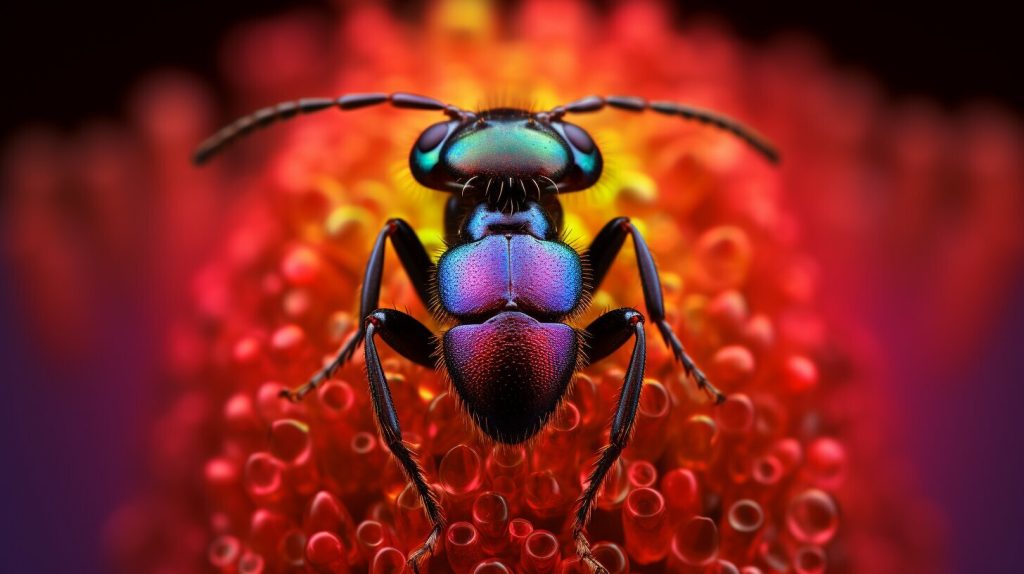
Adaptations in Ants
Ants have developed various adaptations to facilitate the functioning of their cardiovascular system and enhance their survival. For instance, their small size enables hemolymph to flow freely through their body without the need for specialized pumps or vessels. Additionally, their relatively simple circulatory system, which lacks veins and arteries, reduces the resistance that hemolymph experiences while circulating.
Furthermore, ants’ hearts are adapted to their specific needs. They are located closer to the head than to the abdomen, allowing for efficient oxygen delivery to the brain, which is critical for an organism that relies on elaborate communication and coordination.
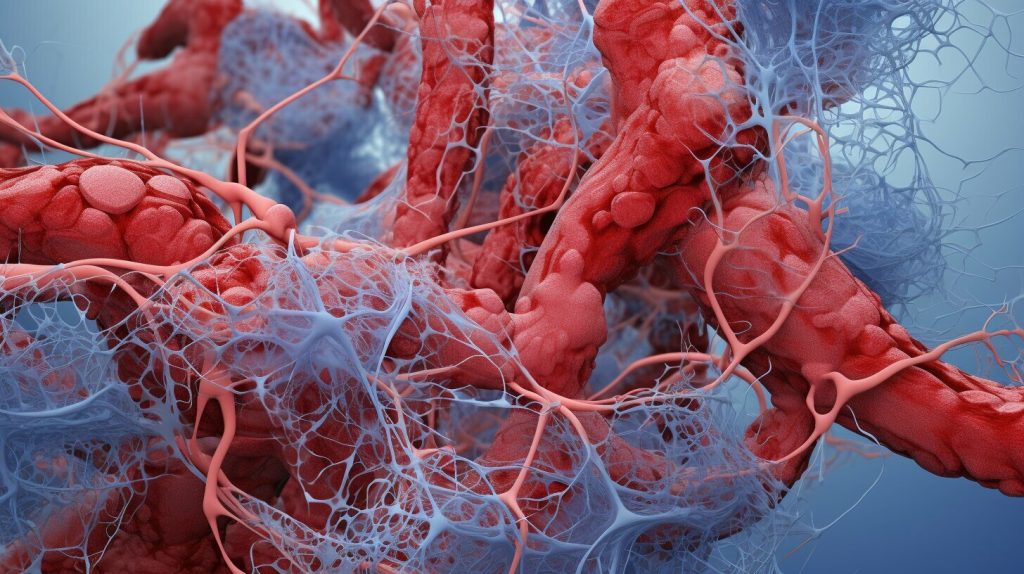
In deserts, where ants experience extreme temperatures, they have developed a method of actively regulating their body temperature by controlling the flow of hemolymph. They also tend to be more active at night, when temperatures are cooler, to avoid the heat of the day.
Some ant species, like army ants, have developed a more complex circulatory system that facilitates rapid repair of severed limbs, an adaptive feature critical for their hunting and foraging activities. Their cardiovascular system is also adapted to allow for the ingestion of large prey, which they consume as a group.
The Intriguing Ant Heart
Ants are fascinating creatures with many unique characteristics. One of the most intriguing aspects of ant biology is their cardiovascular system, including their hearts. Despite their small size, ants have a remarkably efficient circulatory system that enables them to thrive in a variety of environments.
Interestingly, ants are also incredibly resilient to heart disease. While humans are prone to various cardiovascular conditions, ants rarely suffer from heart-related issues. This phenomenon has puzzled scientists for years, and they are still working to uncover the reasons behind it.
One theory suggests that the ant’s diet and lifestyle may play a role in their heart health. Unlike humans, ants consume a diet that is low in fat and cholesterol, which are major contributors to heart disease. Additionally, ants are highly active, engaging in physical activity throughout their lives. This constant movement and exercise could help to keep their hearts healthy and strong.
Another possibility is that ants have evolved unique adaptations in their cardiovascular system that help to protect them from heart disease. These adaptations may include changes in heart structure, circulation patterns, or other physiological processes that have yet to be discovered.
Regardless of the reasons, the fact remains that ants are remarkably resilient to heart disease. Studying these insects and their cardiovascular systems could provide valuable insights into human health and disease prevention.
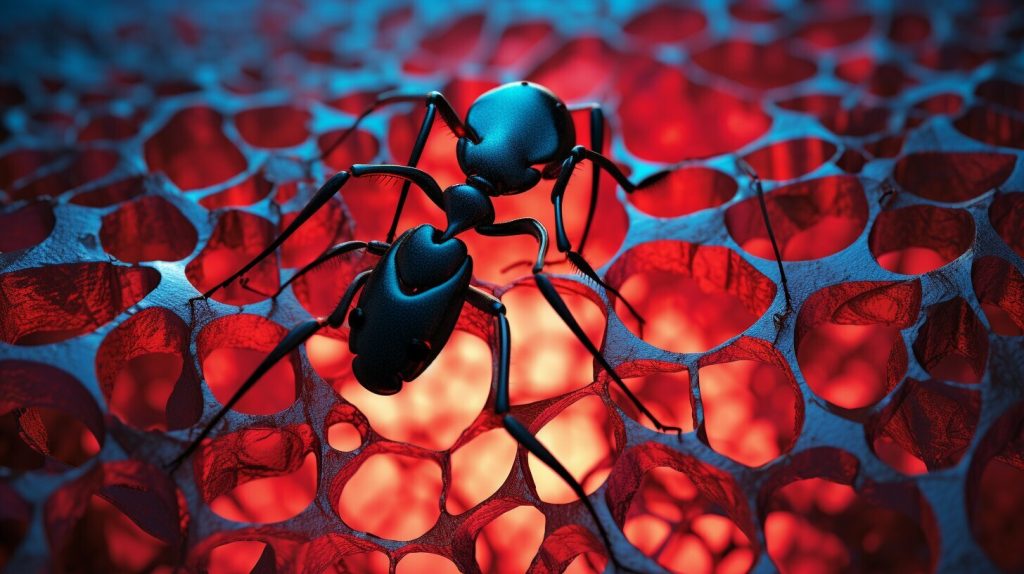
The Importance of Ant Hearts
Ants may be small, but their hearts are mighty! The ant’s heart is a crucial component of their anatomy, contributing to their overall physiology and survival.
Without a heart, ants would not be able to circulate their hemolymph, their equivalent of blood, throughout their bodies. This would severely impact their ability to move, carry food, and perform other essential tasks.
In addition to their individual importance, ant hearts also play a vital role in the functioning of ant colonies. Ants use chemical signals, or pheromones, to communicate with one another, and the circulation of hemolymph throughout the colony helps to distribute these signals effectively.
Overall, the ant’s heart is a remarkable example of the intricate and fascinating nature of insect internal organs. Its importance to both individual ants and ant colonies emphasizes the crucial role that even the smallest organisms can play in the ecosystem.
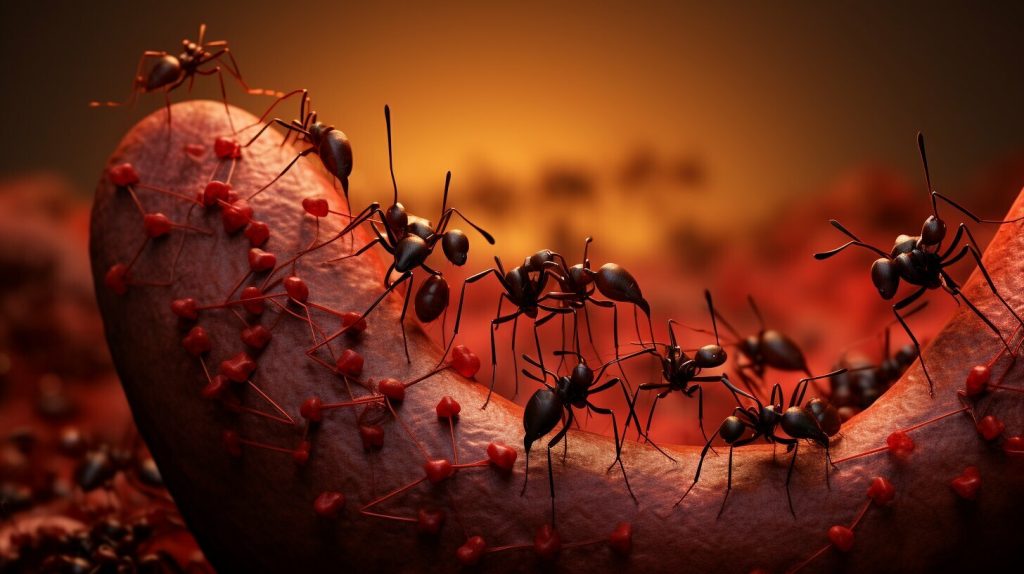
Comparing Ant Hearts to Human Hearts
While the cardiovascular system in ants and humans share some similarities, they also have some striking differences. Insects, including ants, have an open circulatory system, meaning that their blood, called hemolymph, flows freely throughout their bodies. In contrast, humans have a closed circulatory system, where the blood flows through a network of blood vessels.
One of the most notable differences between ant hearts and human hearts is their size. Ant hearts are incredibly small, with some species having hearts that are only about 0.2 millimeters in length. In comparison, the human heart is much larger, with a length of about 12 centimeters.
Ant hearts also beat at a much slower rate than human hearts. While the average human heart beats around 60 to 100 times per minute, ant hearts beat at a rate of only a few beats per minute.
Despite these differences, both ant and human hearts play critical roles in maintaining the overall health and function of their respective organisms. The ant’s heart helps to circulate hemolymph throughout the body, delivering oxygen and nutrients to the various tissues and organs. Similarly, the human heart pumps blood throughout the body, delivering oxygen and nutrients to the cells and removing waste products.
Overall, while there are significant differences between ant and human hearts, both are vital organs essential to the survival of their respective organisms.

Conclusion: The Intriguing Ant Heart
Congratulations! You have now discovered the fascinating world of ant anatomy and their cardiovascular system, including the important role their tiny hearts play. As you’ve learned, ants have an intricate circulatory system that is vital to their survival and resilience to heart disease.
Despite their small size, ant hearts are impressive internal organs that ensure their bodies are constantly supplied with hemolymph. The heart’s structure allows it to perform its function effectively, helping the ant to function efficiently.
Ants have evolved fascinating adaptations that contribute to their cardiovascular system’s efficiency, making them incredibly resilient to heart disease. Their hearts are also crucial to the overall functioning of ant colonies, highlighting their importance in the context of ant biology.
In conclusion, the ant’s heart is a remarkable aspect of insect biology that continues to intrigue researchers and amateur naturalists alike. We hope this article has given you a greater appreciation for the intricate world of ant anatomy and their magnificent cardiovascular system.
FAQ
Q: Do ants have hearts?
A: Yes, ants do have hearts. Their hearts are relatively simple compared to human hearts, but they play a vital role in circulating hemolymph, which is the insect equivalent of blood, throughout their bodies.
Q: What is the anatomy of ants?
A: Ants have a complex anatomy, consisting of various organ systems. These systems include their exoskeleton, digestive system, respiratory system, and reproductive system, among others. Each system contributes to the overall functioning of an ant’s body.
Q: How does the cardiovascular system of ants differ from humans?
A: The cardiovascular system of ants, and insects in general, differs from humans in several ways. Instead of blood vessels, ants have an open circulatory system where hemolymph directly bathes their organs. Additionally, ants have a simple heart that pumps hemolymph throughout their bodies.
Q: How does the circulatory system work in ants?
A: In ants, the circulatory system works by the heart pumping hemolymph into a network of arteries. From the arteries, the hemolymph flows into smaller vessels called sinuses, where it bathes the organs and tissues before being pumped back to the heart. This continuous circulation ensures the distribution of nutrients and oxygen throughout the ant’s body.
Q: What is the function of the ant’s heart?
A: The ant’s heart plays a crucial role in pumping hemolymph and maintaining the circulation of nutrients, hormones, and waste products throughout its body. It ensures the proper functioning of the ant’s organs and supports its overall health and survival.
Q: How is the ant’s heart structured?
A: The ant’s heart is a small, tube-like structure located in the abdomen. It consists of a series of chambers that contract to pump hemolymph throughout the ant’s body. The structure of the ant’s heart is adapted to efficiently distribute hemolymph and maintain the circulation system.
Q: What is the ant’s heartbeat like?
A: The ant’s heartbeat is relatively slower compared to larger animals like humans. It beats at a rate of several times per minute, depending on the ant species. The heartbeat helps distribute hemolymph and ensures the proper functioning of the ant’s organs.
Q: What adaptations do ants have in their cardiovascular system?
A: Ants have various adaptations in their cardiovascular system that enable them to thrive in different environments. These adaptations include the ability to regulate the flow of hemolymph to specific body parts, flexible heart contractions, and efficient oxygen transport.
Q: Are ants resilient to heart disease?
A: Yes, ants are remarkably resilient to heart disease. Unlike humans, ants have a low incidence of heart-related problems. The exact reasons for their resilience are still being studied, but it is believed to be related to their unique physiology and adaptations to their environment.
Q: What is the importance of ant hearts?
A: Ant hearts are essential not only for the individual ants but also for the overall functioning of ant colonies. They ensure the proper distribution of resources and waste elimination, contributing to the survival and success of the ant colony as a whole.
Q: How do ant hearts compare to human hearts?
A: Ant hearts and human hearts have significant differences in terms of structure and function. While both pump fluids to circulate nutrients and oxygen, ant hearts are simpler and have a different circulatory system. Ants rely on an open circulatory system, while humans have a closed circulatory system with blood vessels.

